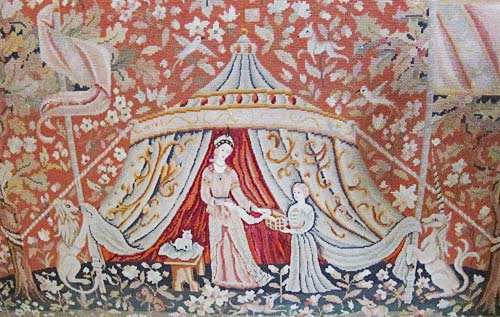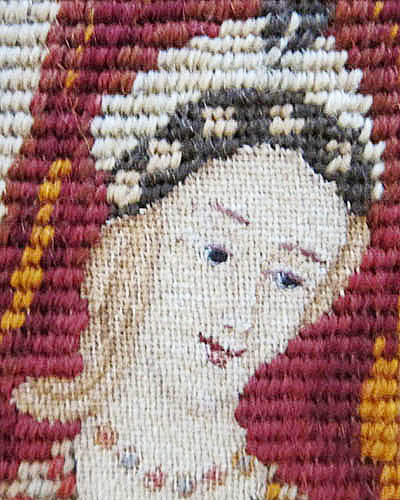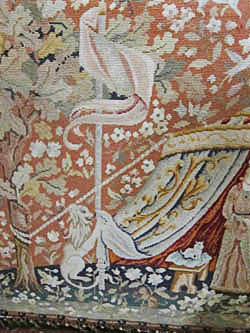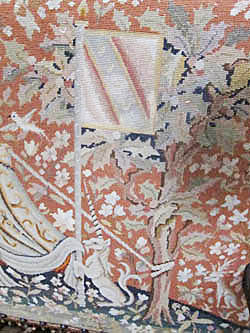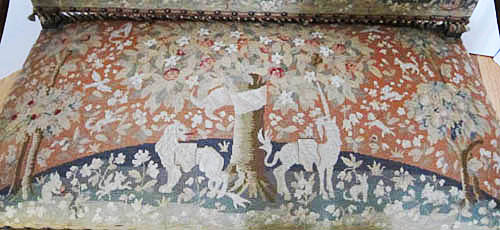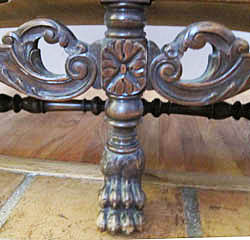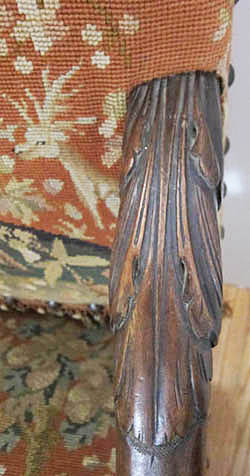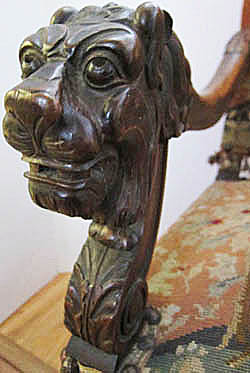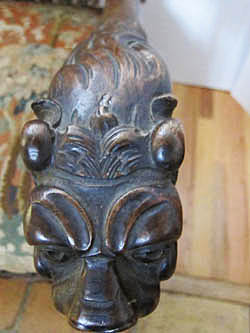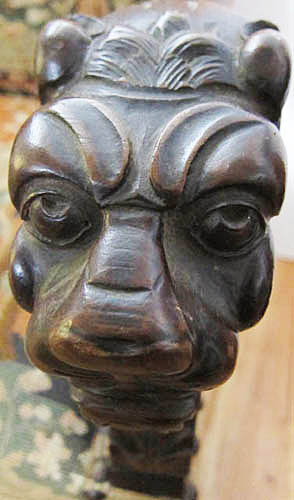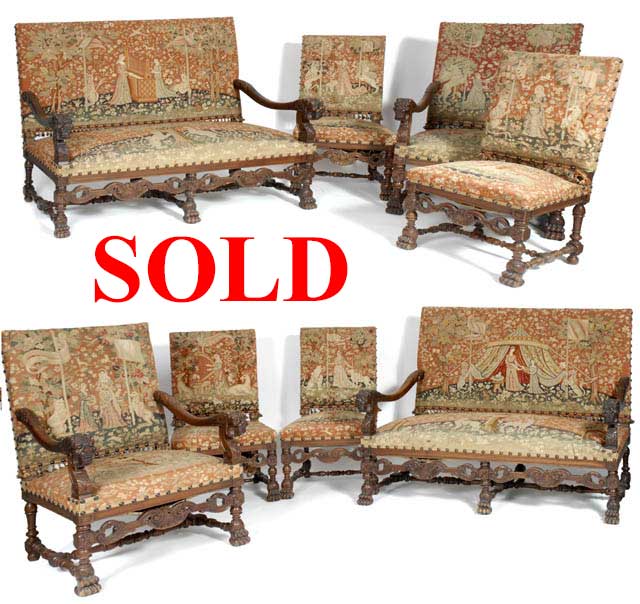
Sometimes in the antiques business, items strike a chord with past experiences and beloved images. Such was the case when we acquired this collection at an auction in Paris.
For both of us, the series of tapestries in the Cluny Museum (now the Museum of the Middle Ages) in Paris, The Lady and the Unicorn or La Dame à la Licorne, is not only remarkable for the artistry but one of the best examples of how tapestries can be appreciated by modern viewers. Illustrating the five senses, the tapestries show the unicorn in various poses, either central to the action (as in the case of Sight and Touch), or as part of the pageantry in a heraldic, rampant pose (as in Taste or the Choosing of the Jewels). Following a two-year restoration, they went back on view at the Cluny in late December, 2013.
The unicorn, a cloven-footed horse with a goat's beard and a long fluted horn, was so wild and swift that no one could capture it by chasing it. Rather, a maiden had to be left in the forest where the untamable beast would come to her and fall asleep with its head on her lap, at which time the hunters would seize it. The miraculous capture was considered to symbolize the incarnation of Christ and tapestries showed the capture associated with the Annunciation. In the six tapestries comprising the Cluny series, the unicorn remains free but tame.
In one of the few instances when the series has left France, it was on view at the Metropolitan Museum of Art in New York in 1974 with other unicorn-related tapestries from the Metropolitan and other museums. The show was a blockbuster. Seeing so many tapestries in one place, up close and personal, spurred a lifetime of interest in tapestries and marveling at the ability to create in woven form realistic scenes and effects including deep perspective, detailed landscapes, and virtuosic renderings of running water and reflections in a mirror. When as newlyweds we moved to Paris, one of our first stops was the Cluny Museum to be re-united with the Lady and the Unicorn panels and re-ignite our fascination with the art of tapestry.
We love the millefleurs style of tapestries (referring to the milles or thousands of small flowers or fleurs making up the background) for their combination of rich decorative elements, such as the many species of flowers portrayed, but also for the inclusion of so many animals - a bestiary in cotton and wool. Each time we visit the unicorn tapestries at the Cluny, it is fun to look for the bunnies standing on their hind legs and rubbing their noses, looking off into the distance, or directly out at us, the viewers.
Unlike many tapestries from the era around 1500, which were also designed in Paris but made in the workshops of Flanders, the millefleurs tapestries are self-contained, lacking landscape or context. In the case of the Lady and the Unicorn, there is a central mound in dark blue-green on which the human figures and the unicorn stand, sometimes with a lion, a dog, a civet, a monkey, and a few rabbits. The flowers and other vegetation depicted in this central mound are planted while those in the rose background are sprigs and branches no longer attached to their roots. How bunnies must have loved this feast for their senses!
The female figures depicted in the six tapestries blend into the background and emerge from it, their richly textured and patterned garments reflective of the value of textiles in the medieval world as treasures far more dear than the furniture over which they were draped.
The pieces making up this set of sofas and chairs reproduce some of the scenes from the Cluny collection but add others in the same style, presumably inspired by the Cluny tapestries but a newer interpretation. The designer has done a remarkable job of capturing the grace and beauty of the original tapestries in these renderings. Needlepoint has been used rather than tapestry, meaning that instead of the fabric being woven on a loom (as were the Cluny originals) it has been stitched onto a canvas framework. The heads of the female figures are executed in petit point, a much smaller stitch over single threads of needlepoint canvas and used for the finest of details.
The pieces in our set (pictured at the bottom of the page) consisted of the following:
Item 5127A (2 sofas, settees or love seats)
Love Seat One - The Choosing of the Jewels, also known as à mon seul désir
Love Seat Two - Hearing or l'ouie
Item 5127B (2 armchairs)
Armchair One - Taste or le gout
Armchair Two - Smell or l'odorat
Item 5127C (4 side chairs)
Side Chair One - Not based on the Cluny set - depicts a woman with a harp
Side Chair Two - Touch or le toucher
Side Chair Three - A variation on taste or le gout
Side Chair Four - Not based on the Cluny set - depicts a woman with animals
Curiously, one of the most touching and symbolic of the Cluny tapestries, the one depicting Sight or la Vue, was not offered at the auction. In the Cluny collection, Sight is represented by the unicorn, its paws on the lady's lap, viewing its reflection in a mirror she holds and perhaps foreshadowing its capture by hunters waiting for it to doze off with its head in her lap. Whether Sight was represented by a piece now missing from this set (perhaps there were originally six side chairs instead of four?) is a mystery.
We have undertaken work to make sure that this set of sofas and chairs is in its best condition possible considering its age. When we received the armchairs and love seats all of the arms were loose where they connect to the backs, and to the seats. Since the reason we bought the set was the beautiful tapestry fabric, we had to undertake our repairs from under the seat and through the back, so as not to remove or damage the existing fabric. From the underside of the seats we found that some of the springs had become untied and some were broken and needed replacing, which we did. All of this work was performed without disturbing the tapestry fabric. For re-gluing and re-doweling the arms at the backs, we had to replace the badly faded plain pink (probably red in an earlier time) fabric, with a new back covering in a sympathetic red.
When we receive furniture from France, we always examine pieces closely to determine repairs needed and how to do them in conformity with preserving the value of antiques. The two love seats or sofas and two of the side chairs had what appeared to be small portions of fabric missing from the tapestry. We cleaned the chairs with air under pressure, so as not to affect the color, or condition of the fabric, and the dust was blown away, as well as what appeared to be whitish spots of drywall compound. Since we come in contact with furniture from so many places, things like this do not surprise us, so we removed these spots as well. But when the whitish spots were removed, it became clear that an insect had been eating away the wool of the tapestry and leaving this residue. Alerted to the problem, we examined each piece carefully and determined that only the sofas and two of the chairs were affected. As we observed for new or active insect damage it became clear that only Sofa Two (Hearing) had an ongoing problem. The kind of insect was a clothing webbing moth, so we tented this settee, and applied a Pyrethrin based insecticide. Since this insect and its larvae are susceptible to this agent and only the larvae do damage to the fabric as they develop into moths and lay still more eggs, we were able to eradicate the larvae and have determined that they are no longer an issue.
Having said all of this, any prospective buyer must keep in mind that there are very small spots in the tapestry fabric that are bare of the surface wool, but in which the underlying cotton foundation is just fine. Detailed photos of these spots are available upon request. There are no holes in which you could, for example, put your finger through.
We investigated repairing the tapestry fabric before we undertook any restoration, and because it could not be repaired while on the furniture, we determined that the cost of removing the fabric, repairing it, and reinstalling it was prohibitive while running a substantial risk of damage to the existing tapestry fabric and it would be lost forever. So for those interested in the set, please be aware that your appreciation of the old fabric must be tempered with the realities that old fabrics are unpredictable in how much longer they will be usable. Because they are old, they may fade more, they may have spots or stains that must be tolerated, since there are unpredictable results from cleaning , wear and repairs.
We love these glorious tapestry images, and must accept that they are not forever, and may fail to give the wear we hope for. We understand this limitation, and trust that out clients will have considered it when they are struck by the extraordinary beauty of the Lady and the Unicorn series.
The moiré or wave pattern on some of the close-ups is caused by undersampling of the patterns in the fabric by the digital camera but are not present on the fabric itself. The colors are most accurately represented by the photos above, as some variation is caused by the camera's flash.
Reference
Campbell, Thomas P., Tapestry in the Renaissance (Metropolitan Museum of Art, New York, 2002). Cavallo, Adolfo Salvatore, Medieval Tapestries in the Metropolitan Museum of Art (Metropolitan Museum of Art, New York, 1993); Souchal, Geneviève, Masterpieces of Tapestry from the 14th to the 16th Century (Metropolitan Museum of Art, New York, 1974); Trésors de L'Art Medieval (Dossier de L'Art No 6, Dijon, February-March, 1992)
Uses
This salon set is a remarkable collection whose stories, depicted on each piece, can be appreciated and treasured in light of their heritage on view at the Cluny.
The Choosing of the Jewels or à Mon Seul Désir
